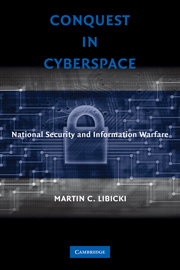Book contents
- Frontmatter
- Contents
- List of Figures
- Acknowledgments
- 1 Introduction
- 2 Hostile Conquest as Information Warfare
- 3 Information Warfare as Noise
- 4 Can Information Warfare Be Strategic?
- 5 Information Warfare Against Command and Control
- 6 Friendly Conquest in Cyberspace
- 7 Friendly Conquest Using Global Systems
- 8 Retail Conquest in Cyberspace
- 9 From Intimacy, Vulnerability
- 10 Talking Conquest in Cyberspace
- 11 Managing Conquest in Cyberspace
- Appendix A Why Cyberspace Is Likely to Gain Consequence
- Index
5 - Information Warfare Against Command and Control
Published online by Cambridge University Press: 05 June 2012
- Frontmatter
- Contents
- List of Figures
- Acknowledgments
- 1 Introduction
- 2 Hostile Conquest as Information Warfare
- 3 Information Warfare as Noise
- 4 Can Information Warfare Be Strategic?
- 5 Information Warfare Against Command and Control
- 6 Friendly Conquest in Cyberspace
- 7 Friendly Conquest Using Global Systems
- 8 Retail Conquest in Cyberspace
- 9 From Intimacy, Vulnerability
- 10 Talking Conquest in Cyberspace
- 11 Managing Conquest in Cyberspace
- Appendix A Why Cyberspace Is Likely to Gain Consequence
- Index
Summary
When tales of command and control gone bad are told, the moral of the story is often how hard waging war is without full information. Commanders ask themselves: where are my forces; what are they doing; what is their condition; have my commands been correctly received and interpreted? Those commanded have their own concerns: do they have the correct orders; do such orders reflect the situation on the ground; and how do these orders compare with what their cohorts have been ordered to do?
Such questions grow more urgent when communications nodes are under attack. Units out of touch cannot receive orders or report back to command. Militaries consequently lose their coherence, and therefore their efficacy. Much of the credit for the relatively easy victory of Desert Storm was ascribed to Iraq's inability to exercise command and control after their communications links were attacked. Information warfare advocates argue that computer network attack should have a similar effect on digital data networks. It is all about information scarcity.
But what if information scarcity is becoming history? What if the real challenge of command and control is how best to cope with a glut of information? What would information warfare look like if it reflected as much? To limn a possible answer, this chapter therefore (1) explains why the era of scarce information is ending; (2) the problems this may cause and how people may cope; and (3) how to think about strategies to explore, exploit, and exacerbate the dysfunctional aspects of information excess.
- Type
- Chapter
- Information
- Conquest in CyberspaceNational Security and Information Warfare, pp. 102 - 124Publisher: Cambridge University PressPrint publication year: 2007



